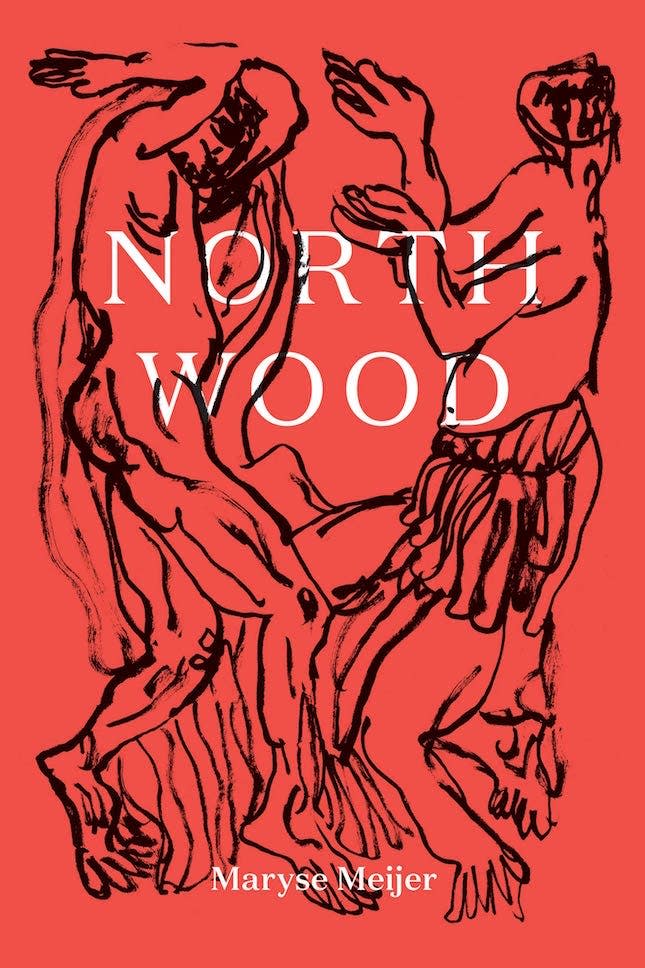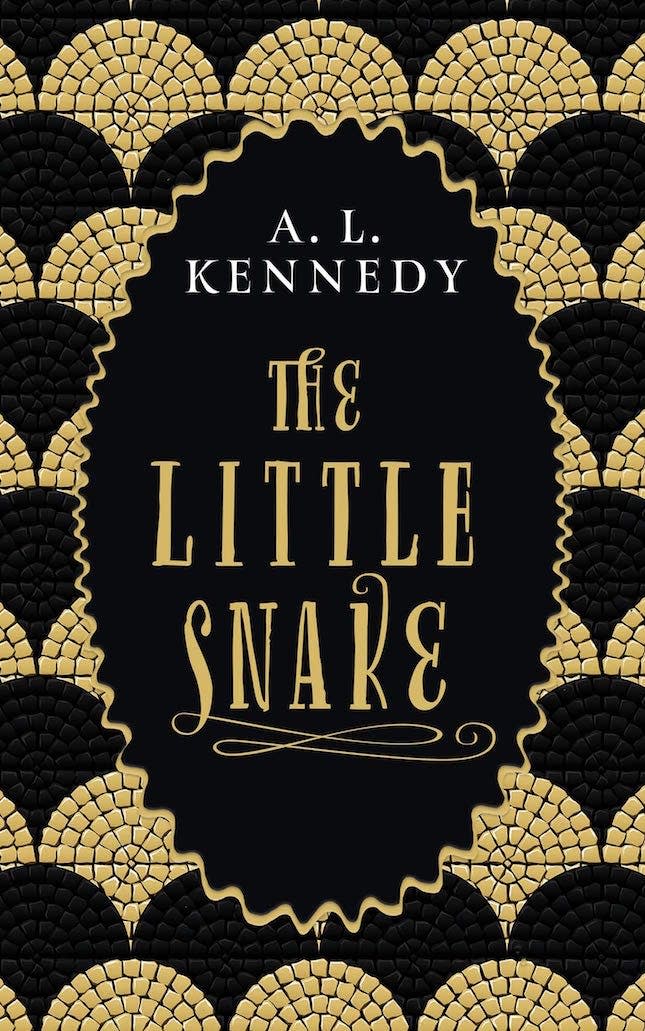3 New Mysterious Feminist Fables
A story doesn’t have to be long to make an impact. The three novellas in this week’s book club all clock in between 100 and 170 pages, but each holds a fable that’s likely to leave a serious impression. Each one wraps a moral message in an eye-catching, legendary package, full of mysterious woods, anthropomorphized creatures and forces of nature. So follow these formidable fabulists into their curious worlds.
1. The Little Snake by A.L. Kennedy ($20): “This is almost, but not quite, the whole of the story about a remarkable, wise little girl. She was called Mary. Everything I will tell you here began when Mary went walking in her garden on one particular afternoon. Mary was a little bit taller than the other girls her age and had brownish crinkly hair. She was quite thin, because she didn’t always have exactly enough to eat. She liked honey and whistling and the colour blue and finding out. She lived in a city filled with very many different kinds of people. Its very many different kinds of people made it a very wonderful place, full of interesting songs and stories, foods and clothes and conversations. Nevertheless, the people in charge of the city were not overly fond of people and so some of the apartments in which the very many different kinds of people lived were often dry where they should have been wet, or wet where they should have been dry, or just cold and dark and supplied with especially listless electricity. In order to enjoy the sky, which was free to them and as large as can be, the people in the wet and dry houses would fly kites from their roofs. Some looked like birds of paradise, some looked like fish and some looked like wonderful serpents.”
It’s easy to see why Kennedy thanks Antoine de Saint-Exupéry in her acknowledgments section — The Little Snake has a fanciful fable feeling not unlike the French writer’s famous The Little Prince, and both touch on the difference between the way adults and children perceive the world. Young Mary loves her garden, which is only the size of a large tablecloth but can be made to seem infinite if she stands in its center without moving — for, that way, she can never find its limitations. One day, Mary encounters Lanmo, the golden little snake of the title. Lanmo and Mary become close friends, as he teaches her potential bullies a lesson in kindness and shares his wisdom. However, Lanmo must leave Mary for longer and longer periods of time to do his true job, acting as a form of Death to those whose lives are over.
When Lanmo visits Mary, he finds a more and more distressing situation; Mary’s family has gotten poorer and poorer, war is on the horizon, and finally bombs have started to drop on the city that is beautiful, but savagely divided between classes: a city Kennedy describes as more suited to birds than people. As a dictator comes into power and the kites stop flying, Mary grows up, falls in love, is displaced, and finds joy and suffering under the watchful eye of Lanmo. Kennedy’s commentary on modern life looks at both its terrors and blessings, finding hope in the humanity that is worth living for.

2. Northwood by Maryse Meijer ($19): Meijer’s fluid, strange novella is told in brief, poetic bursts. A young woman retreats to the darkness of the woods in order to find a quiet place to create art. Instead, she meets an older, married man and begins an affair with him that quickly turns disturbing and violent. Switching between past and present as the woman grows, marries, and becomes a teacher and caregiver, the fable shows her looking back and trying to encapsulate this dark time in her history when she craved the danger and violence.
Filled with fairy tale creatures, the book goes past what we know of many fairy tale stories, showing the extreme violence and control they normalize, and how they insidiously warp the ways we look at the world and behave. Her lover, a writer, writes about her as she draws him, and neither enjoy the pictures they create of each other. Even the formatting of the book belies its arresting nature; published in stark white text on black pages, wrapped in a bright red cover, the poems may stop you in your tracks.
“I saw the light on in the woodcutter’s hut and walked/through the leaves and knocked on the door not knowing/he was there on the porch sitting in the dark a blanket/across his lap he said What. I said I’m alone I can’t start the/fire. My nose dripped. I had no gloves. I thought it would be/warm, my first month in the woods. I just stood there. He got up and I followed him into the cabin, my cabin, and he took/the box of long matches from the mantel and showed me./How dry the wood had to be. Stacked just so. Blow. Smoke/in my eyes. How it stung. Squatting side by side I sniffed the/cold coming off him how long did he sit outside like that in/the dark it was so dark. The fire swelled. After a moment he/left. Sparkle./Snap./And the burn.”

3. The Naked Woman by Armonía Somers, translated by Kit Maude ($17): Metaphors and imagery run rampant in late Uruguayan writer Somers’ book, a classic feminist tale originally published in her native country in the 1950s but translated and released now in English for the first time. In this urgent, still-relevant translation, Rebeca Linke makes a sudden, clean break with social mores and responsibility. Desperate to escape her boring, nothing-based life, she finds the last straw comes on her 30th birthday, to which she has attached much emotional significance, nothing happens… again. Instead, she travels to her cottage in the country, ready to begin a very different journey.
“The cottage at which Rebeca arrived at midnight seemed to be suspended in space. She hadn’t got to know it yet. All she knew was what was in plain sight; a large field stretching out in front of her, abruptly interrupted by the dark silhouette of a sea creature. Right from the start, she thought that the forest looked like a beached whale. On the windy day she first saw it, it had been possessed by a kind of madness, like certain kinds of repressed human anger. The forest moved without moving, exhaling noisy, portentous gusts of wind, rooted to the spot in twitchy bondage. Then it would be still for a time, its indomitable mass breathing quietly. To the right, the leafy barrier didn’t quite reach the river. The river had no name, at least not one she knew, and ran along the forest, separated by a mysteriously clear strip of what was perhaps leaves of sand – something the color of her own personal void.”
What attracts her to the cottage is the ability to escape at a moment’s notice, and she does; in a field, under the moon, she symbolically lops off her own head, and becomes pleased as sensations come back to her body and the head evolves from placidity to anger. When she returns to society, she is completely naked in every sense and renames herself Eve. Her very existence now, naturally, seems to be too much for anyone in the village to handle; the men express their misogyny in a combination of lust and anger, and the women fear the disruption to the status quo that Eve represents. A fable about the exhilaration and dangers of bucking the system, The Naked Woman lays bare the shared insecurities of modern society that become deep-seated hatred of those on the outside.
What books transport you to a strange but familiar world? Tag us in your next fabulous read @BritandCo.
Brit + Co may at times use affiliate links to promote products sold by others, but always offers genuine editorial recommendations.



